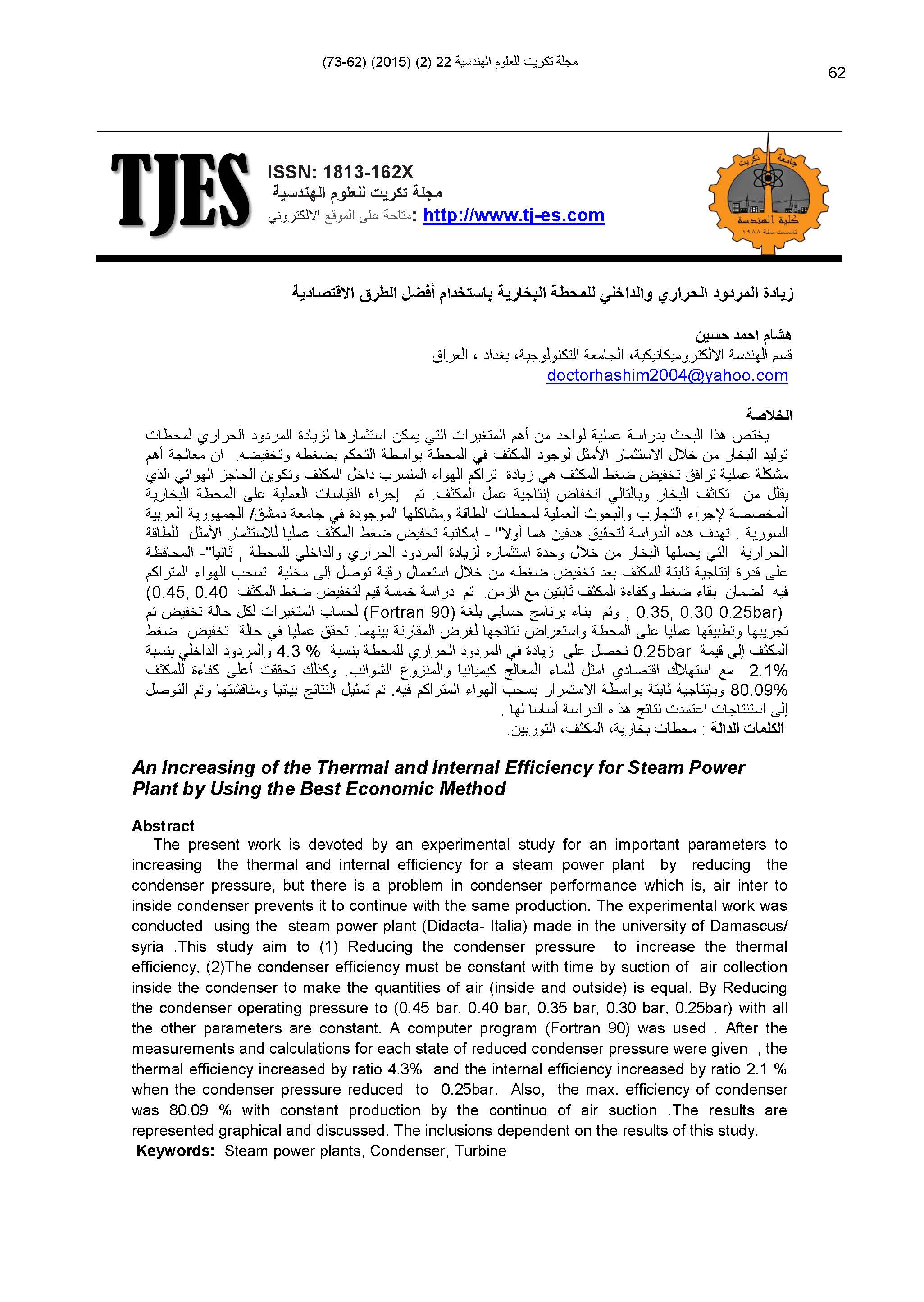An Increasing of the Thermal and Internal Efficiency for Steam Power Plant by Using the Best Economic Method
Main Article Content
Abstract
The present work is devoted by an experimental study for an important parameters to increasing the thermal and internal efficiency for a steam power plant by reducing the condenser pressure, but there is a problem in condenser performance which is, air inter to inside condenser prevents it to continue with the same production. The experimental work was conducted using the steam power plant (Didacta- Italia) made in the university of Damascus/ syria .This study aim to (1) Reducing the condenser pressure to increase the thermal efficiency, (2)The condenser efficiency must be constant with time by suction of air collection inside the condenser to make the quantities of air (inside and outside) is equal. By Reducing the condenser operating pressure to (0.45 bar, 0.40 bar, 0.35 bar, 0.30 bar, 0.25bar) with all the other parameters are constant. A computer program (Fortran 90) was used . After the measurements and calculations for each state of reduced condenser pressure were given , the thermal efficiency increased by ratio 4.3% and the internal efficiency increased by ratio 2.1 % when the condenser pressure reduced to 0.25bar. Also, the max. efficiency of condenser was 80.09 % with constant production by the continuo of air suction .The results are represented graphical and discussed. The inclusions dependent on the results of this study.
Metrics
Article Details

This work is licensed under a Creative Commons Attribution 4.0 International License.
THIS IS AN OPEN ACCESS ARTICLE UNDER THE CC BY LICENSE http://creativecommons.org/licenses/by/4.0/
Plaudit
References
- Moran, M.J. and Shapiro H.N., “Fundamentals of Engineering Thermodynamics”, John Wiley & Sons (Asia), 2000.
- A.Kostyuk and V. Frolov, “Steam and Gas Turbines”, 1988.
- Skrotzi, B. G. A. and Vopat, W. A., “Power Station Engineering and Economy”, New York: McGraw-Hill, 1960.
- Drbal, L.F., “Power Plant Engineering”, Black & Veatch (COR), 1996. DOI: https://doi.org/10.1007/978-1-4613-0427-2
- M. A. Habib and S. M. Zubair, “Second-Law-Based Thermodynamic Analysis of Regenerative-Reheat Rankine Cycle Power Plants”, Energy, Vol. 17, No. 3, pp. 295-301, 1992. DOI: https://doi.org/10.1016/0360-5442(92)90057-7
- A. Bejan, “Theory of Heat Transfer – Irreversible Power Plants”, Int. Jl. Heat and Mass Transfer, Vol. 31, No. 6, pp. 1211-1219, 1988. DOI: https://doi.org/10.1016/0017-9310(88)90064-6
- Babcock & Wilcox, “Steam - Its Generations and Use”, Babcock & Wilcox, London, 2005.
- T.J. Kotas, “The Exergy Method of Thermal Plant Analysis”, Butterworths, London, U.K, 1985.
- El-Dessouky, H.,T.,A., Al-Haddad, A.,Al- JuwayhelF., ''A Analysis of Counter Flow Wet Cooling Towers'', Journal of Heat Transfer, Vol.119 DOI: https://doi.org/10.1115/1.2824150
- M.A. Habib, S.A.M. Said and Al-bagawi, “Thermodynamic Analysis the Ghazian Power Plan “, Energy, 20 (11),1121 – 1130, 1995. DOI: https://doi.org/10.1016/0360-5442(95)00057-N
- Wakil,M.M. “Power Plant Technology”, McGraw-Hill, Singapore, 1984.
- .A. Smith, P.C. Few, “Second Law Analysis of an Experimental Domestic Scale Co–generation Plant Incorporating a Heat Pump”, Applied Thermal Engineering, 21,93-110, 2001. DOI: https://doi.org/10.1016/S1359-4311(00)00051-X





